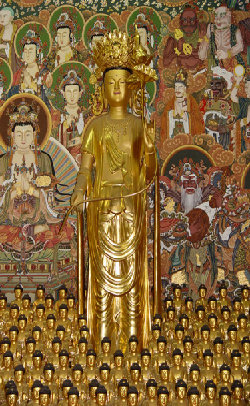Hwagyesa Temple Stay Attracts International Monks
Hwagyesa Temple has a Temple Stay Program that attracts many international monks and nuns so you will find yourself practicing with the foreign monks and nuns there.
Hwagyesa Temple is located deep in the foothills of Samgaksan Mountain even though it is close to the city centre. It was founded in 1522CE during the reign of Joseon King Jungjong, in the Buheodong region of Samgaksan, as the hermitage Bodeokam.
 Bodeokam was a hermitage founded during the beginning of the Goryeo Dynasty in the vicinity of the present current location. This temple received a lot of support from the Joseon Dynasty Royal Family, especially during the reign of King Gojong, when the Queen Mother and her retainers would frequent the temple so it became known as the "Palace Temple".
Bodeokam was a hermitage founded during the beginning of the Goryeo Dynasty in the vicinity of the present current location. This temple received a lot of support from the Joseon Dynasty Royal Family, especially during the reign of King Gojong, when the Queen Mother and her retainers would frequent the temple so it became known as the "Palace Temple".
In 1933, a group of nine Korean Literature Scholars stayed at the temple for a conference to finalize the unified orthography of the Korean Hangul alphabet. But more than anything else, the name Hwagyesa is widely known due to the efforts of the Korean monk, Ven. Seungsahn (1927-2004).
The Ven. Seungsahn started living and practicing at the temple in the mid 1960s. During his frequent world travels, he taught more than 50,000 disciples around the globe. There are more than 100 international monks and nuns who ordained under him at this temple. During his lifetime, Ven. Seungsahn came to be revered as a living Buddha due to his incredible efforts and influence spreading the Dharma abroad.
After he entered Nirvana in 2004, the mourners at his funeral and subsequent public cremation were predominantly international monks and nuns.
Hwagyesa Temple Stay Program
There are still many international monks living and practicing here. If you participate in this Temple Stay Program, you can join in the practice together with the International Zen Centre monks for meditation, mountain hiking and tea drinking. Also, during the Gyeoljae period (3 months meditation retreats every summer and winter), you can join the monastic formal meal together with the monks and nuns.
There are also Dharma Talks in English every Sunday in the International Zen Center. This location does not have the feel of being in a city even though it is still technically located in Seoul. Once you pass through the lljoomun (One Pillar Gate), another world unfolds before you.
Whereas outside of the lljoomun, all the houses are tightly packed together, inside the temple gate, the forest lined road stretches into the distance. The sound of the water resonating from the valley below is yet another gift that welcomes the visitor. People often drop by the stream for a short time just to soak their feet. The practice of 3000 bows held on the last Saturday evening of every month is also very well known.
Fast Facts
Address:
487 Suju 1-dong, Gangbuk-gu, Seoul
Telephone: 82-2-900-4326
Fax: 82-2-990-1885







